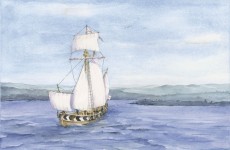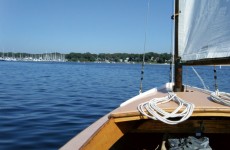Greg Coppa’s Guest Perspective on page 12 – “The Making of a Boat Guest” – hints of a cultural disconnect between those who are schooled in the ways of boats and the water and those who aren’t. This lack of understanding on the part of the latter group can result in tensions aboard – when black-soled footwear scuffs decks and cockpits, marine toilets are clogged, faucets are left running, and self-conscious neophytes refuse to wear life jackets.
Greg writes: “Introducing people to the joys of boating, or to a beautiful body of water, is rewarding and enjoyable. No doubt, there will always be awkward incidents when guests, who have not grown up around the water, are brought aboard boats.”
Chris Gallagher – author of the other Guest Perspective, “Lance Lee and Me” on page 16 – views this divide from another angle. In a recent e-missive, Chris wrote: “I must say, it’s hysterical when we gather on the ‘Sunday porch’, and everyone speaks about the political books they’ve been reading, and I talk about books I’ve been devouring, about cruising in the Pacific, Atlantic, Arctic, etc. All are non-mariners, and none seem to understand the difference between a tropical storm with reefed main and storm jib and Donald Trump.”
The gulf gets wider when we enter the realm of traditional boating lingo. Sometimes in this mystifying digital era – fraught with language that threatens to overwhelm and replace the English tongue – we occasionally feel silly and pretentious saying port and starboard, windward and leeward, forward and aft, bow and stern, ebb and flood, bear off and bear up, and all the other wondrous boat and sea terms and phrases we picked up as a wharf rat.
The late yacht designer Fenwick Williams concurred: In his 1967 monograph, “Nomenclature and Terminology,” in The Catboat Association’s “The Design Elements of a Catboat,” he wrote: “One sometimes has an uneasy feeling that many people look upon nautical language as something of an affectation or a childish sort of play-acting.”
Maybe we’re just weary of the blank looks evoked when the newbie at the helm is told to leave the nun to starboard. Wouldn’t it be easier, we ask, to speak in his or her own language, then dust off the correct terms when boating with other shellbacks?
Perhaps, but to do so would be grossly unfair to the newcomer to boating.
H.A. Callahan, a boating authority of the first half of the 20th century, is unequivocal about this: “You cannot hope to sail a boat unless you learn to call things by their proper names. Everything on a boat has a name, and it is very necessary to learn these names if you are to learn the functions of all parts of your boat.”
Fenwick Williams elaborated on this imperative: “It is doubtless true that undue addiction to ‘avast’ and ‘ahoy’ or ‘alow’ and ‘aloft’ can become a little silly, especially when there is not much more aloft than a piece of aluminum tubing, but when used with some discretion and restraint, the time-honored language no more than reflects the respect that is due the traditions of the sea.”
“There are times when proper wording could prevent a considerable foul-up,” he added. A simple example, he said, would be in the use of aft or astern – aft referring to locations on board a boat, astern to positions beyond the vessel. Astern of the mast could, for the sake of conjecture, connote a seamark behind the mast of another vessel within your view; aft of the mast only means a position sternward aboard the boat you are on.
Similarly, port and starboard mean, respectively, left and right while facing forward. If a boating tyro was facing aft while the boat was beating in a lumpy sea, and the skipper, trying to speak the lubber’s language, said to close the right-hand (meaning starboard) opening port, it would be on the crew’s left-hand side. The nautically illiterate tenderfoot could get confused, open the wrong port, and allow green water below.
Aft and forward, bow and stern, windward and leeward, and port and starboard have zero tolerance for further interpretation. These terms render skippers’ requests black and white, thus avoiding “considerable foul-ups.”
“Maybe, in time, port and starboard will be dropped entirely, but not, we hope, while this aging fist is still capable of grasping a catboat wheel or tiller,” averred Fenwick Williams. “In the present state of things, it appears hardly less gruesome to use front and back, or rear, instead of bow and stern. Certainly we could hold to that much these many years to come.” We’re with Mr. Williams on this one.




 We have complete issues archived to 2009. You can read them for free by following this link.
We have complete issues archived to 2009. You can read them for free by following this link.